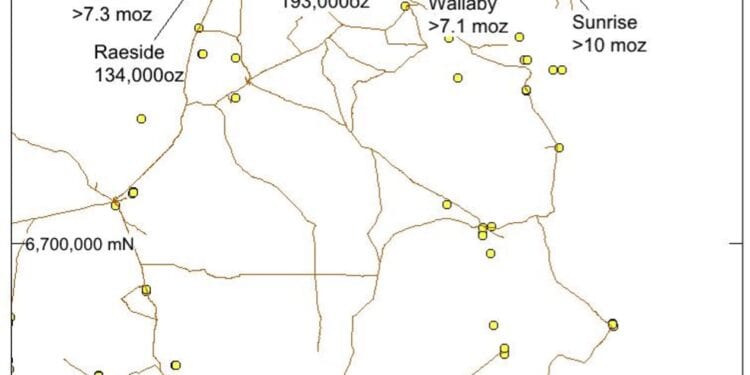Infill Drilling Hits 4m @70g/tAu From Surface
Magnetic Resources (ASX:MAU) has recorded a number of high-grade intersections from part of an infill drilling programme that was completed prior to the end of 2020 at the HN9 Project in Western Australia.
The last drilling programme completed includes 86 RC holes for 5.033m and was designed as infill drilling to help establish an Indicated Resource both within the three km long NNW and the NE main mineralised trends.
Highlights from assays received to date include: 4m at 70.7g/t from 0m; 4m at 5.7g/t from 12m, 4m at 5.1g/t from 56m; 3m at 3.4g/t from 40m; 12m at 1.2g/t from 52m; 8m at 1.6g/t from 64m; 8m at 1.4g/t from 32m; and 8m at 1.3g/t from 28m.
Assays are still pending for 32 RC drillholes totalling 2,026m from this programme.
Managing Director, George Sakalidis, said that within the three km mineralised shear zone there are now many new shallow intersections with a total of 601 intersections (ranging from one to 12m) greater than 0.5g/t Au, which includes 255 greater than 1.0 g/t Au, 95 greater than 2.0 g/t Au, 47 greater than 3.0g/t Au and 34 greater than 4.0 g/t Au.
“With the Australian gold price at near record levels of $2,365 the HN9 Project being only 15km NW of the Granny Smith Operations owned by Gold Fields Australia Pty Ltd and only 10km NE of the Jupiter Operations owned by Dacian Gold Ltd and 35km north of the Sunrise Dam deposit owned by AngloGold Ashanti Ltd at Laverton, is shaping up and has potential for a large-scale shallow deposit with the addition of a large thickened mineralised zone trending to the NE containing some high-grade intersections and many large thick intersections with potential for bulk tonnage,” Mr Sakalidis said.
“This significant three km mineralised zone is so far defined by 769 RC holes totalling 42,557m is coherent. Extensive drilling is planned both for infill and extension drilling to get the resources to an Indicated Resource status and to test the new Southern Thickened Zone over a four km length
“The multiple stacked lodes within the Central Thickened Zone have similarities to the stacked lodes at the Wallaby, Sunrise Dam and Jupiter major gold deposits.
“A further very ambitious drill programme of 98 RC drillholes for 11,937m is planned and the shallow seismic survey results are due to start in mid-February, which will map the subsurface structure and potential intrusions and deep-seated tapping structures for the three km long HN9 deposit.
“We are looking forward to testing a number of promising intersections and potential extensions and potential large-scale targets generated from the shallow seismic survey down to 300-400m depth, which in recent times has been increasingly used in and around operating gold mines.”
Magnetic has accelerated a number of major drill programmes in the New Year at HN9 and Lady Julie with two rigs in use.
These programmes are proceeding with 98 RC holes for 11,937m at HN9 and 97 RC holes for 7,595m at Lady Julie.
These drilling programmes are planned to test and extend the three km coherent drilling intersections pattern (greater than 1.0 g/t Au) at HN9 to a four km length and to test mineralised zones 1km to the south of the Southern Thickened Zone and 1.5km west of HN9.
At Lady Julie the drilling will cover a three km length linking various mineralised drilled zones and historical workings within four long NS mineralised linear shear zones.
A new thickened intersection of 90m at 0.37g/t Au from 80m which includes eight metres at 2.5g/t from 80m has been located in the southern part of HN9.
This intersection is only 60m north of an intersection of seven metres at 3.04g/t Au from 108m.
This new Southern Thickened Zone is 600m south of the original Central Thickened Zone has some very thick intersections including 104m at 0.82g/t Au from eight metres in (including 20m at 2.23g/t Au from 95m and 70m at 0.49g/t Au from 13m. The areal extent of the mineralisation is growing in the southern direction and remains open to the northeast and at depth.
At Hawks Nest 9 (HN9) extensive drilling programmes have been completed. including 769 RC holes totalling 42,667m (average 55m depth), 10,178 two to five metre composites and 6,090 1.0m splits.
The southern part of HN9 is now interpreted to split into up to four NE-trending mineralised zones that are open to the NE and SW and are now being tested over a total length of 1100m.
In addition, other areas are being assessed for their potential for thickened zones and the results from a shallow seismic survey are due in mid-February, which will help outline the scale of existing thickened zones, other thickened zones, intrusions at depth and controlling deep seated structures for the three km long HN9 mineralisation. The seismic survey will assist in a deeper drilling programme below the current average drilling depth of 55m down to 300 to 400m depth.












